|
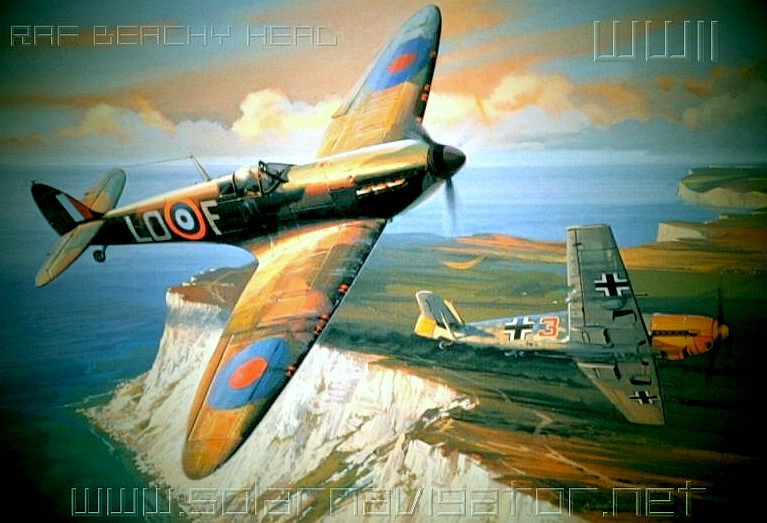
RAF Beachy Head - CEW Rotor Station
- TV590959 - Eastbourne
Beachy Head, the most southerly point on the chalk cliffs to the west of the town of
Eastbourne, East Sussex, has a long history as a location for observation and warning.
In 1826 a local vicar by the name of Rev. Jonathan Darby erected a light in a cave to the west of Beachy Head above the high water mark, at the foot of the cliffs. The cave below was accessed by the Reverend through a shaft to the bottom, down which he was lowered by some of his parishioners. This light provided warning to ships blown towards the rocks below by the relentless South Westerly gales. It undoubtedly saved many lives.
An improvised light tower was built on top of the cliff in 1828 adding more range to the light. This structure gave way to the Belle Tout
Lighthouse made famous by the Media due to its moving on rails away from the eroding cliff edge and repositioning. Belle Tout was abandoned in the early 1900's to be replaced by a new Lighthouse built on the rocks below the Head to the East, due to the location high on the cliff often being obscured by fog. The Lloyds Corporation established a watch station on the Head in 1877, to monitor the movement of passing vessels, using an arrangement of coloured flags for communication. It remained in use until the outbreak of the Second World War when it was requisitioned for use by the R.A.F. who installed a Radar Station on the surrounding land, which was part of the network of Chain Home (CH) stations around the country.
After the Second World War activity slowed upon the Head and almost returned to normal with tourists returning to the area after 6 years of closure, to enjoy the popular hospitality of the Beachy Head Hotel. Aerial photographs of the surrounding area taken in 1949 still show craters from bomb damage close to the area of the Signalman's Cottages and Hotel. Further West tank tracks and shell holes mark the landscape defining the area below Belle Tout that was used as a firing range. This took its toll on the old Lighthouse, which was a ruin after the war.

THE
COLD WAR
The start of the cold war reintroduced Beachy Head's importance as a strategic lookout. In 1950 under the Air Ministry's top secret plan designated ROTOR that provided radar cover for the United Kingdom in the event of an attack from the air, negotiations started between the Air Ministry and the Ministry of Town and County Planning, to build a " control and reporting station" on the cliffs. The M.T.C.P was having none of it to start with, who seemed to put objections to the Air Ministry at every turn.
This infuriated the Air Commodore in charge of the program who wrote in reference to the Planning authority "If the principle to be applied is that our defences are to take second place to public amenities, then the public should, I suggest, be reminded that instead of rambling over the Sussex Downs, they may be rambling over the Russian Plains with the cheerful prospect of digging salt when their hike is over."
Negotiations continued until a compromise was reached. The local planning authority sat in a closed session on the 21st of September 1950 and approved the construction of a "Air Ministry Radio Station". This led to the leasing of 4 acres of land on the cliff top directly opposite the Beachy Head Hotel to the Air Ministry. The proposed station was given a code of " Site No. 3" (later coded `HEB') to designate itself within Rotorplan. It was to be of an R1 type underground construction providing Centrimetric Early Warning (CEW) capabilities.
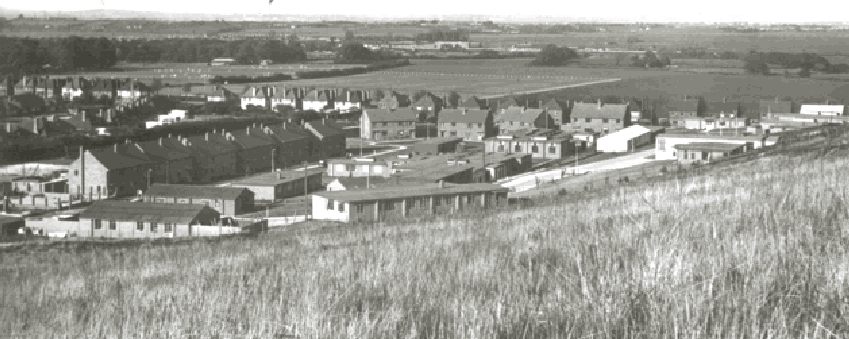
KINGS
DRIVE, EASTBOURNE - How many people living in the quiet cul-de-sac
near Hampden Park, Eastbourne, just off Kings Drive realise the part that their houses played at the height of the cold war.
The above picture shows what is now Rangemore Drive and Twineham Road -
and in the background (missing of course) the Eastbourne District
General Hospital, now built on the fields.
To many National Service Men in the fifties it was home from home, a far cry from the cold wooden barrack huts of Bridgenorth and Compton Bassett. Such structures would not have been welcomed by the Eastbourne City Fathers of those days and so we enjoyed the luxury of the houses which still remain almost as they were then.
Almost the same, for then there were large heating ducts running at the rear which carried a central heater system from a remote solid fired boiler house. North Sea Gas would not be discovered and in use for at least three more decades.
The only remaining ancillary building now is the old Officers mess now used by the
Air Training Corp. (ATC) Ref: Bernard Parke
The works were awarded to George Wimpy a local civil engineering contractor, who by early 1952 had the hardened underground installation and the surface buildings completed. A domestic site for R.A.F personnel was constructed within the town of Eastbourne at a site in Rangemore Drive. (This still survives to this day as the local Air Cadet unit).
Auxiliary power was provided by the provision of a purpose built generator house built to resemble a barn on one of the nearby Council farms. Fitting and testing of the technical equipment was finally complete on the 18th December 1952 when the station was handed over to Fighter Command from the Ministry of Supply.
On the 19th December 1952 the RAF fitters, mechanics and operators commenced a fourteen day familiarization of the new ROTOR equipment that ended on the 5th January 1953. Beachy Head was now an operational station. In the summer of 1954 local residents of Eastbourne noticed the construction of a new bigger radar array upon the cliff. Beachy Head had received the new Type 80 Mk1 radar, installation works were completed by 5th September 1954.
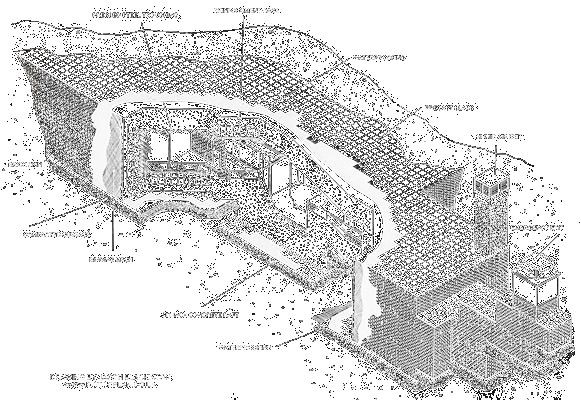
UNDER
CLIFF - A typical underground radar station complex as may have been
found at Beachy Head during the cold war period.
Beachy Head was put on engineering standby on the 1st November 1957, finally closing in 1960.
In August of 1960 the Air Ministry advertised a public auction and distributed catalogues listing the redundant plant and electrical equipment at Beachy Head. The town Clerk, Mr. Busby who was also the civil defence controller was incensed at the move. He had been writing to the Ministry for two years trying to obtain the station as a local civil defence control room. The Ministry had always told him that the station was not redundant and it still was required for the defence of the country. Officials from the Home Office intervened and a meeting between all three parties was held in Eastbourne. It lasted for more than 3 hours. Finally the Air Ministry agreed to stop the sale. Despite Mr. Busbys hard work in stopping the auction, Beachy Head never became a civil defence control room for Eastbourne due to financial implications. The equipment was eventually auctioned off and the bunker gutted of anything valuable.
The local Police adopted the guardhouse at the entrance to the compound, it made an ideal site due to the existence of the RAF police dog kennels. Its central location was perfect for the downland mounted policeman P.C. Harry Ward and his horse "Jumbo" who was very popular with the tourists. Stabling was moved from the west to its new site within the compound of the guardhouse. From his new location Harry Ward was in a better position to attend the cliff rescues that were part of his duties as a patrolling officer. Harry was lowered many times over the cliff edge on primitive rescue equipment to recover
suicide victims and dogs that had fallen and become lodged on the ledges below.
Early one Sunday morning, late September 1963, members of the Demolition team of the 21st SAS Territorial Regiment started to clear the surface buildings. The buildings proved to be stronger than first expected so the team packed in more explosives and tried again. Demolition had to be abandoned until the next day when the manager of the nearby Hotel complained that his windows had cracked. The task of clearing the remaining buildings at this stage was taken over by the South Coast Demolition Co. of Eastbourne.
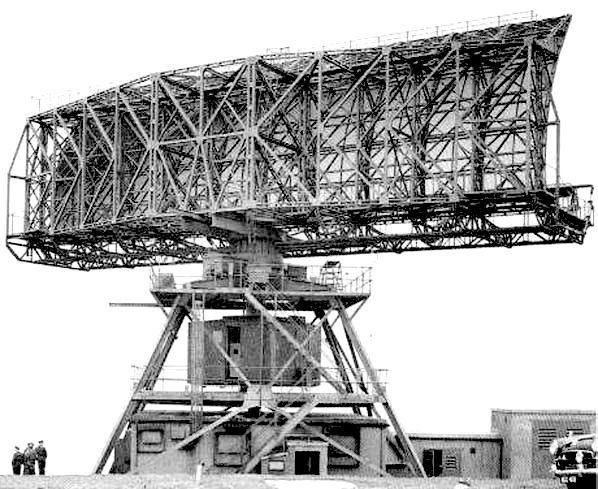
BEACHY
HEAD RADAR
All above ground was cleared except the guardhouse. The stairwell access behind the guardhouse was demolished, this was capped along with the emergency exit, humid air exit and the cable shaft. The only way into the bunker was via a small manhole set into the concrete slab placed over the stairwell.
When P.C. Ward retired the local coastguard took over the guardhouse along with the cliff rescue duties. The bunker hit the local headlines again in the early 80's when a plan was put forward to turn it in to a seat for local government, this was rapidly forgotten when the estimate for works was submitted by the Borough Engineer's. In 1988 a private company approached Eastbourne Borough Council with view to restoring the bunker as a tourist attraction, unfortunately this also did not work out.
In 1996 the guardhouse was demolished during extensive remodeling of the buildings at Beachy Head, the coastguard moved across the road into a purpose built station next to the Hotel. The compound that was cut into the mound where the guardhouse stood was filled back to profile and grassed over. Access was still available to the bunker for interested parties through the manhole, but due to vandals constantly breaking off the padlock's it was locked again and buried under two tons of soil. One night a determined gang dug down to the hatch and broke in. The next day a large tree trunk was pushed down the hole by a JCB and back filled with chalk thus sealing the bunker.
Little exists to give away the location now apart from a few concrete slabs around the site. Many tourists stand now upon the mound above the bunker looking out to sea, unaware of what is below their feet.

RAF
HERSTMONCEUX, LIME PARK
MIRACLE
SURVIVOR IN 2014 AND AN EXTREMELY RARE MONUMENT AT RISK
RAF
HERSTMONCEUX
During
WW2, the buildings
seen above served as accommodation
for wounded RAF aircrew, working with the early warning radar
station at RAF
Wartling. RAF Wartling succeeded RAF
Pevensey, continuing into the 1950s Cold War period.
RAF
Herstmonceux (LPHT) is friends with two landowners at the Pevensey
marshes, who are custodians of the extant artifacts on their
sites, and
like us (our curator) have struggled with local authority to
gain recognition. So well done chaps and chocks away.
CONTACT
US
The
Curator
Lime
Park Heritage Trust
Herstmonceux
Museum
Lime
Park
Herstmonceux
East
Sussex
BN27 1RF,
UK
Telephone:
0044 1323 831727
Email:
energy@solarnavigator.net
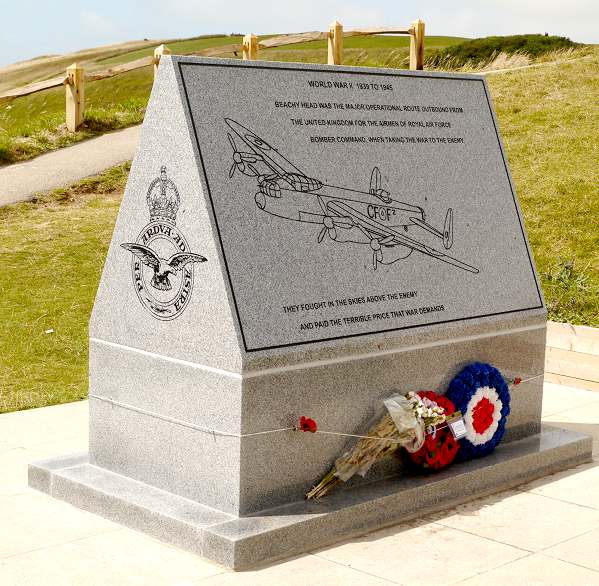
LOCAL
HISTORY
- A commemorative monument to the men who flew countless missions across
the channel to Germany and other European destinations during WWII. Hundreds of people lined Beachy Head April 28 2013 to witness the long-awaited unveiling of a monument to commemorate wartime heroes.
The crowds gathered for a poignant service in the presence of former members of the Royal Air Force (RAF) who served during the Second World War.
The memorial marks the sacrifices made by the 55,573 men of Bomber Command and commemorates their final mission on April 26, 1945 to destroy Hitler’s Eagle’s Nest.
Beachy Head was many of the airmen’s last sight of England before entering enemy territory.
REAL HEROES - Richard Miles from East Dean, who attended the service, said:
“It’s excellent. My father was part of Bomber Command and was shot down in August 1943.
“He was one of only three survivors on his aircraft and the pilots essentially gave up their lives to try and save the others on board by keeping the plane steady enough for them to jump out – real heroes.
“But sadly he died in 2003 so he never really experienced the recognition here in Beachy Head.
“It’s a very fitting tribute and it was a touching service.”
Another former RAF serviceman John Johnstone from Eastbourne is quoted
as saying of the monument: “The most striking thing for me is the line “for many, Beachy Head would have been their last sight of England”, so it’s great to see a lot of people here.
“I think it’s a measure of the respect Bomber Command have and this [memorial] is long overdue.”

David
Rose, 83 years young
TONY
ATCHERLY, DENISE BENNETT, DAVID ROSE - MEMOIRS MAY 2014: “NO one fought better or more bravely than the Germans, obeying the mad, merciless command to defend to the death every inch of ground, futile as it proved.”
As we remember VE-Day, it is easy to image Germany crumbling before the Allied advance as it swept through the Reich.
But victory in Europe was by no means all downhill after D-Day the previous June.
It was the result of an arduous, three-pronged campaign that saw Allied troops (from Britain, the US and Russia) battle their way into Germany from France in the west, Italy in the south and Russia in the east.
And it was the Russians who had the task of plunging the dagger into the heart of Berlin, where Adolf Hitler and some of his henchmen lived their last days.
Berlin was the bull’s eye. Competition between the armies to be first into Berlin ramped up the assault. Initially the US and British troops were keen for a piece of the action, until it was revealed that, prior to invading the country, Germany had been split into zones – and Berlin was in the Russians' zone. But Josef Stalin, in co-ordinating two massive armies which eventually outnumbered the Germans by ten to one, was able to create a rivalry that expedited the fall of Berlin.
Advancing with one gun for every 13ft of the front, they wanted more than just to win – they wanted revenge.
The fear of an impending Red Army from the east was too much for the remaining Berliners to bear, with some taking their own lives rather than fall into the hands of the Russians. Germany fought the Russians right up to the last moment. Even when the Russians reached the Reichstag, the country’s parliamentary centre and a monolithic symbol of Nazi Germany, on April 30, they were halted by heavy fire.
The Russians did not mess around and blasted the building from point-blank range with heavy artillery.
But even then the Germans held on. The Russians stormed the Reichstag in the evening and, after fighting from room to room, hoisted their flag four hours later amid the roaring mess.
By the morning of May 1, Hitler was dead, committing suicide in his bunker under the building.
Still the Germans fought their cataclysmic defeat. Even when the Russians said they would accept the full, unconditional surrender of Germany, the Nazis refused.
It was only after Joseph Goebbels killed his six children, wife and himself that Berlin did eventually surrender.
The first document of unconditional surrender was signed in the early hours of May 7, as reported in the Evening Argus at the time.
But Russian leader Stalin wanted the Germans to surrender in Berlin, possibly out of spite, meaning the masses across Europe had to wait until May 8 for a second surrender to be signed.
For Denise Bennett, VE Day could not come soon enough.
The 86-year-old of Mile Oak Gardens in Portslade was subjected to bombings and direct machine gun fire from German planes during the Battle of Britain.
She recalls going to Ford Aerodrome to pick up her brother with her mother and father when German dive-bombers struck.
She was dragged to the ground by a nearby serviceman as bombs fell around her.
She said: “A bomb dropped quite close to us – it was pretty terrifying.”
Another time, she was playing hockey with school friends when a German bomber started machine gunning them.
They had to run for cover and hide in a ditch until the danger had passed.
The match was umpired by future England hockey player Barbara West, whose death aged 100 was featured in The Argus last November.
Mrs Bennett even picked up one of the many bullet cases scattered on the ground by the plane’s turret guns and still has it today.
“It was a terrible, terrible time,” she recalled.
Living in Balfour Road, Brighton, at the time, she remembers VE Day five years later.
She was cycling in Preston Park when she heard people cheering the news. Later, a crowd went to the Clock Tower in Brighton and danced and sang.
Mrs Bennett said: “We knew what it was all right. You just felt elated – it was terrific.”
“We were just thankful we weren’t going to get bombed anymore.”
Aside from these pleasant memories, she said she had many others she wanted to forget.
Her Polish husband came to Britain in 1946 to clear the beaches and Downs of bombs.

Dennis Manville,
now 76 is seen in this picture, third row down, second left - at Mafeking Road,
Brighton, duing the VE Day celebrations
Another local who remembered the big day was Dennis Manville, 76, of Stanmer Villas in Brighton, who was only a small boy when the victory announcement came.
He lived in Mafeking Road with his family, in a house with a Morrison shelter in the dining room.
It was one of his overriding early memories. His recollections of VE Day itself largely centre on a picture of him with others celebrating.
He said: “Everybody was friendly back then.”
His siblings had their close shaves – his sister was in the playground of Coombe Road School when a German plane flew over and started shooting at them.
She escaped injury, though a bullet went straight through the face of the clock on top of the building – a clock that is still there to this day.
His brother was not as lucky. Walking down a street one day, he kicked an unexploded sulphur bomb, which then went off.
He spent a year in hospital recovering from debilitating injuries and Mr Manville only really got to know him after he came home.
Even younger, John Underwood was only three-and-a-half when VE Day finally came.
Nevertheless, he has vivid memories of a street party in Hollingdean Terrace, Brighton, also attended by his mother and her parents.
He said: “We had a meal all together at trestle tables under garlands of bunting, which, barely visible in the picture, seemed so colourful to me amid the greyness of the times.”
Now 73, he spends his time between Bramber, near Shoreham, and a second, rented home in Brussels, where he worked as a conference interpreter before retirement.
He added: “Think for a moment of where we would all be had the Allies not won.”
David Rose, 83, of Winton Avenue in Saltdean heard the news on the radio back in 1945.
“We knew the saying ‘Careless talk costs lives’,” he said, “But that got around like grease lightning.”
Mr Rose had two brothers – one in fighter command and one in bomber command.
He said: “When they said the war was over my mother was jumping for joy. I was delighted – everybody was. Things were only going to get better.
“But nothing really changed overnight. As youngsters we were excited like anybody. You were just pleased it was coming to an end.”
Only a young boy, Mr Rose remembers a torchlight procession through Rottingdean, from the village pond up to Beacon Hill, where a large bonfire had been built by the Royal British Legion, with fireworks around it.
Mr Rose said: “Goodness knows where they got the fireworks from, as none were available in the war years.”
He describes bunting and coloured lights around The White Horse pub.
The following June, King George sent a letter to boys and girls at schools across the land.
It read: “I know you will always feel proud to belong to a country which was capable of such supreme effort; proud, too, of parents and elder brothers and sisters who by their courage, endurance and enterprise brought victory.
“May these qualities be yours as you grow up and join in the common effort to establish among the nations of the world unity and peace.”
Narrative by: Adrian Imms
VE
DAY CELEBRATIONS - FRIDAY 8TH MAY 2015, THE
ARGUS
Seventy years ago today the Allies declared victory in Europe. ADRIAN IMMS reports on the anniversary
IT was the day Europe had been waiting for – for almost six long years.
After the turmoil of the Battle of Britain, the Blitz, false hopes and the fear of invasion, the Second World War came one step closer to its final curtain on May 8, 1945.
By the time the Germans capitulated, the war had claimed 50 million lives.
Now, on the 70th anniversary of this moment, services are being held across
Sussex.
There are several VE Day beacon lighting ceremonies tonight at 9.30pm to mark the anniversary of Winston Churchill making his speech formally announcing the end of the war in Europe.
A beacon will be lit in the grounds of Blind Veterans UK in Ovingdean, Brighton, at 9.30pm.
The public can arrive at the reception of Blind Veterans UK (formerly St Dunstan's) from 8.30pm, before gathering outside in the east side of the grounds at 9.15pm for the lighting ceremony.
A local blind veteran supported by the charity, 95-year-old Clifford Gower, will read out an official tribute as part of the ceremony.
Blind Veterans UK will also be cutting a large “VE” into the grass before the event to mark the anniversary. Another beacon will be lit at the same time on Worthing seafront. Its foreshore beacon can be found to the right of Worthing Pier if looking towards the sea.
Burgess Hill Mayor Ann Jones, accompanied by war veteran and chairman of the local
Royal British Legion David Truran BEM and a cadet from the local Air Training Corps, will light a beacon at St John’s Park in Burgess Hill at the same time.
Councillor Jones is quoted as saying: “The community could not let this day pass without reflecting on the sacrifice, courage and determination of the people who saw us through this dark period.”
The Burgess Hill Bonfire Society will lay the beacon and the Burgess Hill Marching Youth will parade and provide music from 9pm.
During the day, a cafe in Peacehaven holds a celebratory event called Stepping Back In Time.
Peggy Berry’s De Ja Vu, in South Coast Road, will be playing all the classics from back in the day with bunting and balloons out in force.
Then, on Sunday, an open-air service is to be held at the War Memorial in Old Steine, Brighton, at 3pm.
Open to all, it will include a wreath laying ceremony and two-minute silence.
The event is being co-ordinated by Brighton and Hove City
Council, the Royal British Legion and other partners.
Ref:
Adrian Imms
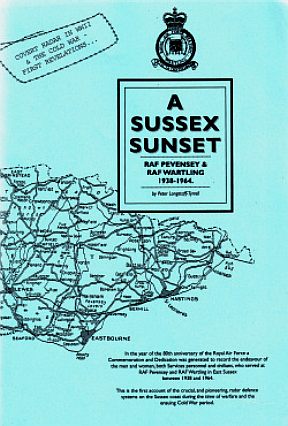
A Sussex Sunset by Peter Longstaff Tyrrell
Subtitle... RAF Pevensey & RAF Wartling 1938 - 1964
ISBN/Cat.No... 0-9521297-2 X
Publication... Gote House Publishing Co
Format... A4 Paperback
Published... 2002
Pages... 80
RR Price... Ł6.00 + p&p
Summary
In the year of the 80th anniversary of the Royal Air Force a Commemoration and Dedication was generated to record the
endeavor of the men and women, both services personnel and civilians who served at RAF
Pevensey and RAF Wartling in East Sussex between 1938 and 1964.
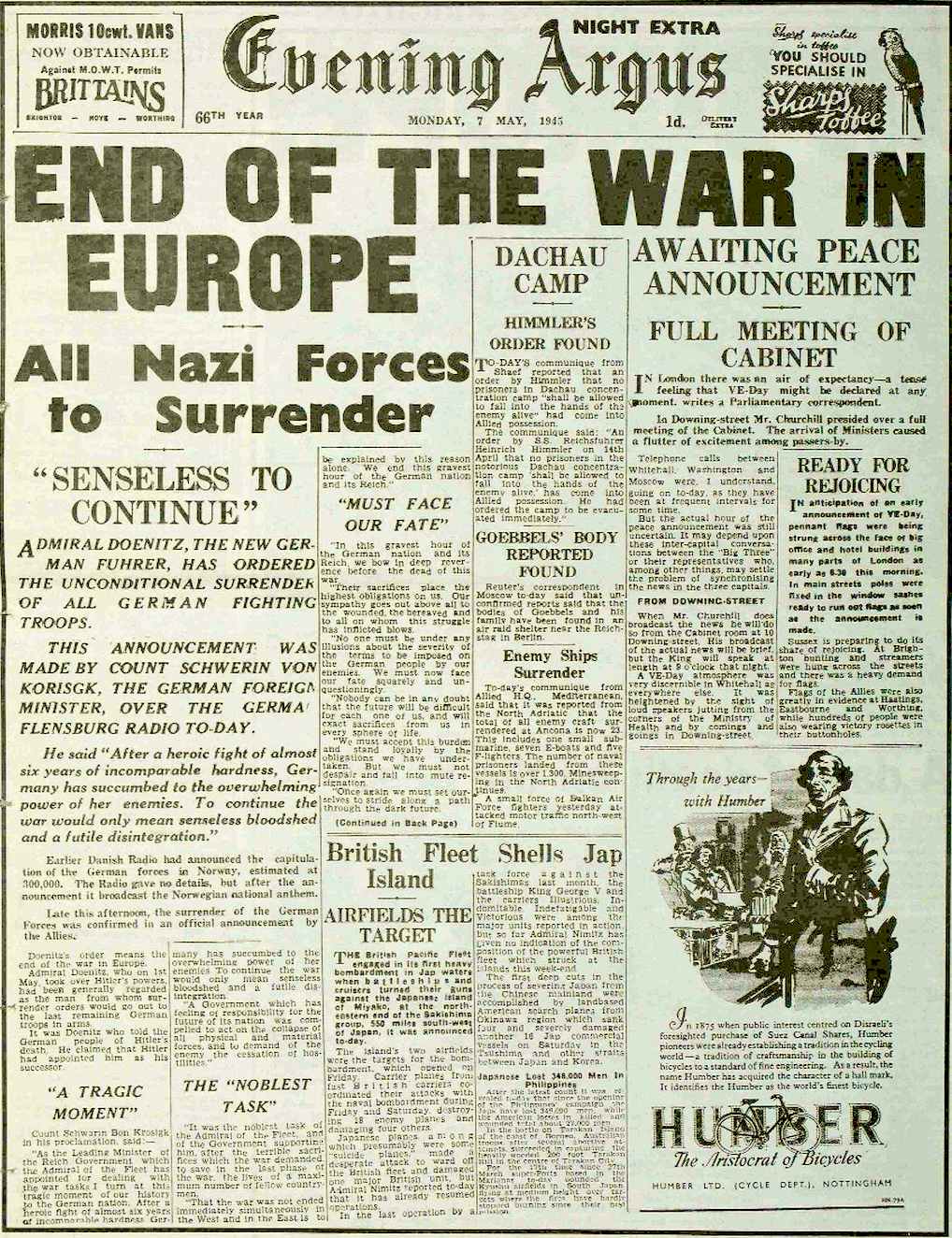
LINKS
& REFERENCE
Tyrrell
Sussex books
Maureens
Choice A_Sussex_Sunset
Subbrit
beachy_head
The
Argus celebrating_our_victory_in_Europe
British
armed forces nat_bernard_parkes
Pastscape
Beachy Head
Eastbourne
Herald a-history-of-raf-beachy-head
Wikipedia
RAF_Beachy_Head
http://www.britishlegion.org.uk/
https://www.forces-war-records.co.uk/units/2085/raf-beachy-head/
http://www.britisharmedforces.org/pages/nat_bernard_parkes.htm
http://www.pastscape.org/hob.aspx?hob_id=1477156
http://www.eastbourneherald.co.uk/what-s-on/magazine/a-history-of-raf-beachy-head-1-1439150
http://en.wikipedia.org/wiki/RAF_Beachy_Head
http://www.theargus.co.uk/news/12939474.Celebrating_our_victory_in_Europe/
http://www.subbrit.org.uk/rsg/sites/b/beachy_head/
http://www.raf.mod.uk/
http://www.tyrrellsussexbooks.com/books_3.php
http://www.maureenschoice.co.uk/book_windows/a_sussex_sunset.html


For three months in the long hot summer of 1940 the British Royal Air Force and the German Luftwaffe fought an epic battle in the skies over the Southeast of England. Britain seemed unprepared against an undefeated Germany, yet by the end of the summer the Luftwaffe was in retreat.
HERITAGE
INDEX A - Z
AIR
RAID SHELTER
AVIATION
- EASTBOURNE
BARCLAYS
BANKING LET DOWN - MISSING ACCOUNT MONEY
BARON
CARL VON ROEMER & CHARLES de ROEMER
CAMPBELL
HALL - BLUEBIRD ELECTRIC CARS
COAL
BUNKER
GAS
ENGINES - COAL CONVERSION, INTERNAL COMBUSTION
HX
FIRE STATION
HX
MUSEUM
HX
SCIENCE EXHIBITS
OBSERVATORY
- HERSTMONCEUX CASTLE
SX
MUSEUMS
PLANNING
APP JAN 2015
RAF
BEACHY HEAD
RAF
HERSTMONCEUX
RAF
HERSTMONCEUX & WARTLING
RAF
SEAFORD BAY
SOLAR
LADY - STATUE
SUMMER
SOLSTICE
SUSSEX
TRUGGERY
THOMAS
ALVA EDISON
TOURISM
DCMS
TREE
HOUSES -
TREE
PRESERVATION
TRUGS
WORLD
ELECTRIFICATION HISTORY
WWII
BOMB PROOF SHELTER

SEVEN
SISTERS - Looking very much as they did during World War Two, these
cliffs are pictured looking from Seaford
Head towards Belle Toute lighthouse (Eastbourne) which you can see
in the distance on the right. Photo December 2014. The location map
below shows the location of Beachy Head in England.

|












